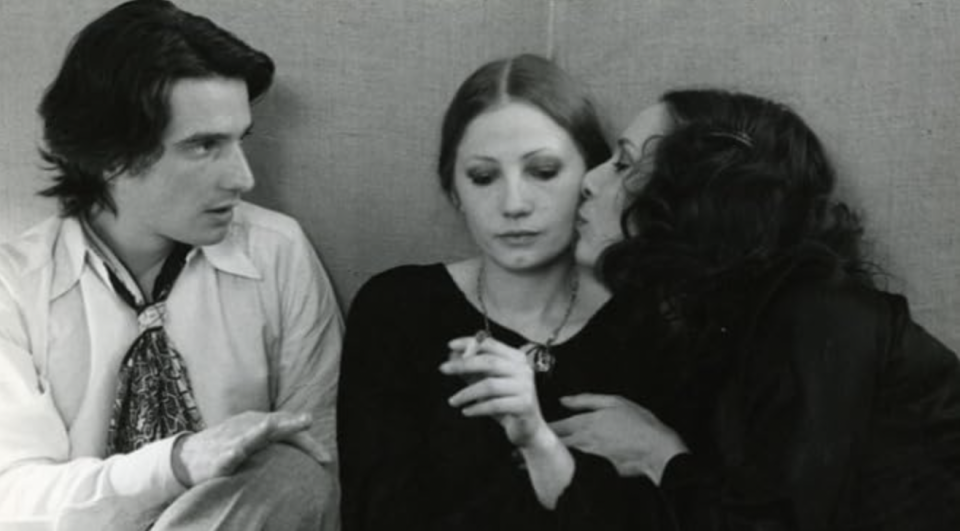Itching for More Ménage-à-Trois Cinema After ‘Challengers’? Consider Jean Eustache’s ‘The Mother and the Whore’

[Editor’s Note: The following article contains spoilers for “Challengers”]
Despite the implications of this story’s headline, these two films are not alike. Well, they are. Kind of. In some regards. Mainly in the sense that the focal point of each is centered around the clashes that come as a result of non-monogamy and specifically the challenges of maintaining civility within a ménage-à-trois relationship. There’s also a connection between the two leads of each film, Zendaya and Jean-Pierre Léaud, in that both began their careers as children and used these roles to expand audiences’ perceptions of them as adults. Perhaps most tangentially, the two films cover time periods of great social ignorance — Post-’60s France and Pre-2020 America (as well as Pre-Housing and Financial Crisis America) — and are aimed at sparking the public’s curiosities, albeit in completely different ways. Thankfully, this piece does not aim to strictly draw comparisons between the two films, but rather convince readers and cinephiles alike why viewing both side-by-side could expand one’s perspective on a subject matter not often explored.
More from IndieWire
Let’s begin with “The Mother and The Whore” — or for those francophiles out there, “La Maman et La Putain” — now available to view on The Criterion Channel after decades in the abyss of physical media rights issues. Simply put, this film is a beast. It clocks in at nearly three hours and forty minutes, consists of almost all dialogue scenes shot in 1.37:1 on 16mm black-and-white film, and features a central character who, if they were around today, would most likely be an online troll. For some, this will sound like heaven, but others, surely, a slog. Enter “Challengers” — a sleek, sexy tennis-slice-of-a-sports-drama that comes at viewers with a voraciousness likely to make them weak in the knees (a point that plays an important part in the plotting of the film as well). It’s a movie that examines athleticism as a form of sexuality and how often dominance becomes an ingredient to passion. But how does dominance take form? Who really holds the power? With these questions is where a central line between these two films can be drawn.

In “The Mother and The Whore”, the fulcrum of the sexual triad is a male intellectual — perhaps a journalist, perhaps just a malcontent — named Alexandre. This character is best viewed not only as a stand-in for the film’s writer/director Jean Eustache, but as a representation of all the lost youth of post-WWII France and the subsequent student and civilian uprisings of May 1968. For those unaware of these events, the most recent reference can be found in the Timothée Chalamet sequence of “The French Dispatch” in which Wes Anderson lovingly satirizes the conflict and conversation around it.
Alexandre is a drifter incapable of finding ground, yet when his romantic interest, Gilberte, decides to wed another at the beginning of the film, the experience upends his entire state of being, sending him and the two women whose orbits he chooses to inhabit next on a self-immolating journey of sexual and emotional satisfaction. Rather than empathize with his subjects or even himself, Eustache turns a caustic lens on his characters, pillorying their behavior by letting others view it. In revisiting the film for its remastering in 2022, Richard Brody described it in the New Yorker as a “radical movie, yet its radicalism is ironic, even evasive, because, far from embodying the ideals of the May Days, ‘The Mother and the Whore’ is radically conservative.”
To put this in context, in 1973 upon its release at Cannes, Eustache was using this film to both pay homage and call out his French New Wave forebears for expanding the form in radical ways, but not using it to really comment on issues or move society forward. For all the progression that figures like Truffaut, Godard, and Rohmer brought to cinema and what they thought it represented, there was a traditionalism at their core that with his film, Eustache both derides and painfully accepts. For as much as we want things to change as human beings, there’s also a comfort in the status quo and we’ve all played victim to it. Both films seem drawn to documenting the changes time has wrought, “Challengers” choosing to do so by volleying back and forth across decades, years, weeks, days, and hours, while “The Mother and The Whore”, despite following a linear track, is constantly referencing a past that’s slipped away. Spending all day at cafés extolling, smoking, and drinking may have seemed like la joie de vivre in 1960s Paris, but in the ‘70s, comes off as gauche. Similarly, the great narrative shifts in “Challengers” are often set in relics of Americana we’ve collectively lost a taste for, yet touch us with remembrances. Motel rooms with broken ACs, Applebee’s parking lots, country-club tennis courts, and even college campuses become tinged with a sense of romance and disdain.
For each individual in each film, the sense that something was lost way-back-when eats away at them, driving all the characters towards victories both hollow and deep. If life is about power — about dominance — then realizing you have none can make a person lust after it that much more. It’s oxymoronic, yet because of the situations they’ve created for themselves and histories they share, these characters can’t seem to escape this cycle of self-indulgence. However, with “Challengers”, writer Justin Kuritzkes and director Luca Guadagnino aren’t exclusively interested in the world around the figures they choose to study, but also the world these figures have conjured up. It’s a world of sweat and pain and triumph and failure and everything in between is just a game. There’s sexiness and fun within this conceit and yet dig a little deeper and a political message does appear by the end in a rapturous conclusion that sees Mike Faist’s Art and Josh O’Connor’s Patrick embrace after years of in-fighting, much to the joy of Zendaya’s Svengali-like figure, Tashi. The message is this…isn’t it better to love in spite of hate than to hate in spite of love? Or as Guadagnino put it in Variety recently, “It’s beautiful to kiss people!”

Unfortunately, it’s a sentiment and question that feels trapped back in 2019 when the main bulk of the story is set, a moment in America that feels like a before-time — an era where our ignorance had not become fully apparent as it did in subsequent years. How can we kiss and make up in today’s world where physical brutality and disinformation continues to push us further and further apart? Are we supposed to just take it to the court and duke it out? And yet, the confines of the world Kuritzkes and Guadagnino create and Zendaya, Faist, and O’Connor populate somehow insulate us from these questions. In this way, it feels like a much older, carefree piece of cinema — something Rian Johnson and others point to as more akin to a Wilder or Lubitsch film like “Design For Living”. And it does do what movies, in a classic sense, are supposed to do. It takes us away — wraps us up in the fury of the sport — edges us with sensuality and implication — gets our hearts beating in sync with the characters. It does this with shot composition, blocking, setting, music, and editing techniques that make us feel like we’re inside the experience. And god, does it feel good. But feelings pass. And soon you’ll be looking for more. That’s when a film like “The Mother and The Whore” will feel revelatory.
The characters in Eustache’s film talk about sex a lot, sometimes with florid language, sometimes with dispassion, but the actual depictions of the act make it seem altogether displeasurable. They engage with one another not out of lust or desire, but out of conquest, because Alexandre, as well as Marie and Veronika, the women he spews his regressive invective at, all need to feel some sense of control again in a world and time that feels so lacking. And so, how does dominance take form in relationships? Who really holds the power? To view these questions through the lens of “Challengers”, the answer would be whoever is capable of beating the other, but also, whoever is capable of never accepting defeat. After her career-ending injury towards the middle of the film, Tashi Duncan knows she’ll never compete on the court again, and yet that sense of competition is still inside of her throughout. No matter who wins the match in the end, Art or Patrick, she will always be the true winner because she set the stage. All she ever wanted was a great fucking match and that’s what she got. She put them on that court and brewed enough animosity between the two to allow them to find their fire for the sport and each other again.

In this sense, a fourth figure infiltrates the threesome in a not-so-subtle fashion — that’s the game of tennis itself. It is part of what drives them towards one another more often than what drives them away and becomes essential to their eventual release. Similarly, the character of Gilberte in “The Mother and The Whore”, who appears only briefly, but is discussed at length, serves as another not-so-invisible force that drives the narrative between Alexandre, Marie, and Veronika. For Alexandre, his inability to claim Gilberte and his rage and indignity over finding out she’s marrying the man who helped her get an abortion is what propels him to take advantage of two women who seemingly really are willing to care for him. By the end, his quest for dominance leads him straight into a trap, the reality that eventually he’s gonna have to grow up, probably sooner rather than later. In both these films, dominance is what draws these characters together, but it’s these not-so-invisible forces that end up holding the real power. An apt metaphor for the issues we face today and the ones we did back then.
Best of IndieWire
The Best Father and Son Films: 'The Tree of Life,' 'The Lion King,' and More
The 10 Best Teen Rebellion Films: 'Pump Up the Volume,' 'Heathers,' and More
The 28 Best True Crime Shows Streaming Now, from 'Under the Bridge' to 'The Vow'
Sign up for Indiewire's Newsletter. For the latest news, follow us on Facebook, Twitter, and Instagram.

 Yahoo News
Yahoo News 
